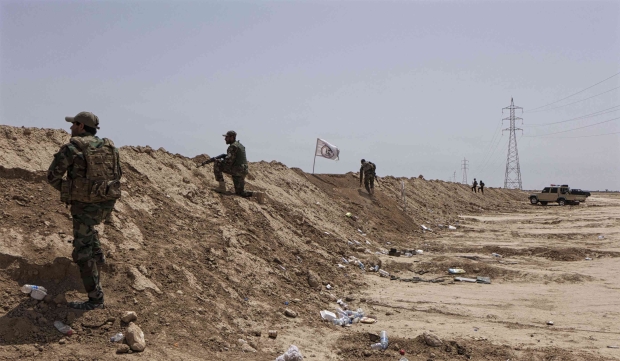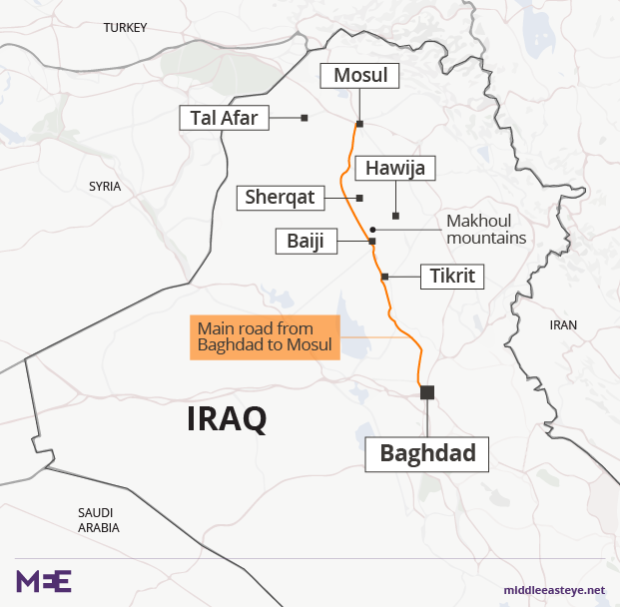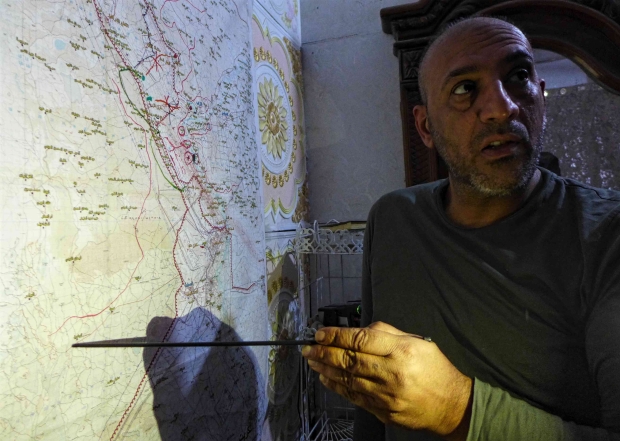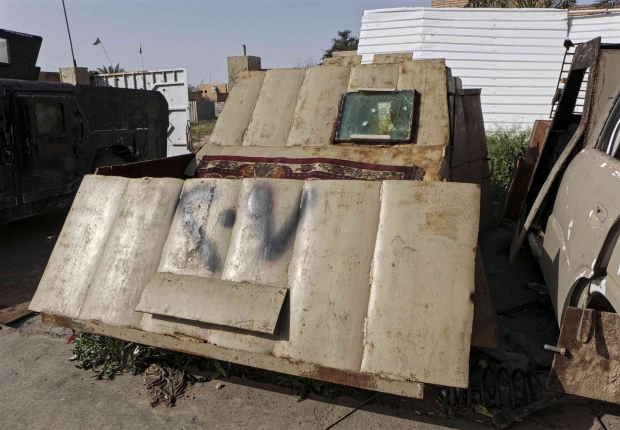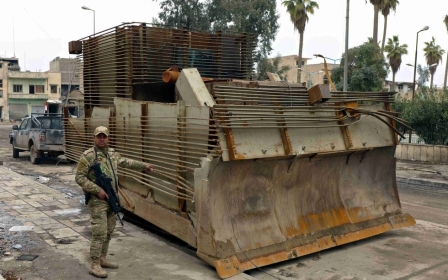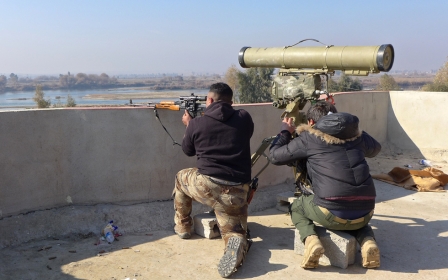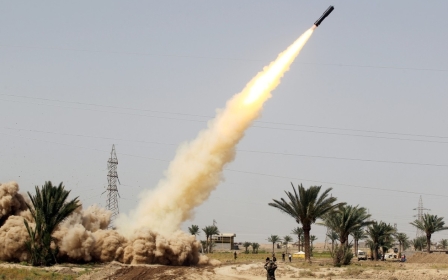Islamic State fight each other, try to flee, as Iraq's next big battle looms
Soldiers fan out through long spring grasses, softly filling a strategic defence trench dug by Iraqi forces. They check for the presence of rogue Islamic State (IS) militants or IEDs that may have been planted overnight.
An explosion rips through the air, throwing up a huge cloud of dust and sand. It sounds like an incoming mortar. More alert than ever, the soldiers press on through the grasses. One climbs out of the trench and retrieves the base of a plastic unit with a wire trailing from its empty core, shouting back that the source of the explosion was an inadvertently-triggered IED, one of hundreds laid to thwart daily IS attacks.
The government-held route is a lifeline for Iraqi troops fighting north in Mosul. It is also all that keeps the militants holed up in the IS-occupied town of Hawija, 40km to the east, from escaping into the Iraqi desert that stretches towards Syria.
Saad Swar, 42, commander of the 99 Brigade, told MEE: "We are between two enemies here, with Daesh [IS] on either side, and they attack our positions every single day.
"They want to control this road because it forms a bridge that they can use to escape from their territory in Iraq to the Syria borders. We are here to prevent Daesh escaping to Syria."
While he speaks his soldiers take up positions, scanning the horizon. A few kilometres from the trench a black flag flutters, miniscule amid the distant sand-coloured Makhoul mountains.The mountain range, dotted with palaces belonging to former Iraqi ruler Saddam Hussein, is controlled partly by IS, partly by Iraqi forces, and is interspersed with stretches of no-man's land.
IS fighters attacking the road from the Makoul mountains are coming from Hawija. It's the second-largest Iraqi town that the group still fully controls, now that it is losing its grip on its former stronghold of Mosul.
The desperation of Islamic State
Even while the battle for Mosul rages, Iraq's armed forces are preparing for the country's next two major offensives: Hawija and the larger desert town of Tal Afar.
Meanwhile, Swar said, the militants are preparing to flee. "Right now our forces are starting to surround Hawija, and the enemy has become desperate to escape," he said.
Mohunnad Najim Al-Eqabi, media head of Hashd Al-Shaabi, said the road is a crucial supply line for Iraqi forces battling IS in the ongoing Mosul offensive. If this logistics route is severed, then the whole operation to the north will break down.
'They are desperate to get this road but our defence is strong. We have killed hundreds of Daesh here over the last month but still they just keep on coming'
- Riad Konia Abu Salem, soldier
Riad Konia Abu Salem, 67, is a former oil engineer turned soldier. "This has been going on for a month,” he shouted cheerfully from the back of a Toyota hurtling over the war-battered tarmac. "Every night Daesh attack us, usually from the mountain side, sometimes from the other side, and every morning we push them back.
"They are desperate to get this road, but our defence is strong. We have killed hundreds of Daesh here over the last month but still they just keep on coming."
The attacks are increasingly ferocious, which Swar said indicates how desperate IS militants have now become to flee Iraq.
Before, IS mainly relied on small groups of fighters, individual suicide bombers and mortar attacks. Now they are increasingly using car bombs packed with explosives.
As they withdrew, disgruntled militants turned on each other in the mountains, which amused Hashd Al-Shaabi fighters observing them through binoculars.
"After the failure of that big operation, Daesh started fighting each other in the mountain and, according to our intelligence and sources, the leader of that operation and his security guy were both killed in the fighting," Swar said. "IS has a lot of internal problems and disputes now, especially between Iraqi and foreign members."
'After the failure of that big operation, Daesh started fighting each other in the mountain ... IS has a lot of internal problems and disputes now'
- Saad Swar, commander
He listed high-level IS personnel whom his forces have killed during the past fortnight: Abu Mariam Al-Kurdi, the commander of a unit specialising in laying IEDs and mines; an organiser of suicide missions known only as Al-Ghamusy; and Ayoub Al-Ansari, a senior IS leader.
Al-Kurdi's M16 gun has now been integrated into 99 Brigade’s arsenal, which is steadily being boosted by IS weapons regularly seized after their failed attacks. Swar raiseed his own M16 and patted that of the soldier beside him, saying with a smirk that both were taken from the enemy.
Rooms of ammunition, roads of burned-out wrecks
Islamic State newsletters, which are circulated on social media, gloss over how its daily attacks are being routinely repelled, and regularly glorify its operations, referring to the predominantly Shia Hashd Al-Shaabi forces by the pejorative term "Rafidi Mobilisation".
In an update released on 9 May, IS listed attacks that its fighters carried out in the preceding few days, including targeting the front lines with 62 mortars and five SPG-9 rockets, destroying an anti-aircraft gun and military vehicle. It also claimed successful sniper attacks on soldiers driving along the stretch of road near Baiji.
The deserted Baiji school is a sort of museum of IS attacks. It has rooms packed with thousands of deactivated IEDs and ammunition and weapons
This part of the route has seen some of the most intense activity among the thousands of kilometres of desert frontlines manned by Hashd Al-Shaabi forces. For this reason, the 99 Brigade that holds this portion of the road is constantly boosting its defences: in front of the trenches, it has already laid more than two square kilometres of minefields to thwart attacks.
Nearby, military engineering units are deactivating vast minefields laid by IS around the nearby town of Baiji and its former sprawling oil facilities, destroyed by the militants before they were pushed out of the area by Iraqi forces in October 2015.
The deserted Baiji school, now the 99 Brigade's headquarters, serves as a sort of museum of IS attacks. It has rooms packed with thousands of deactivated IEDs and ammunition and weapons seized from the group, including handmade Grad missiles.
A pile of hundreds of plastic containers - deactivated IEDs containing C4, an explosive incendiary favoured by IS - are piled in a corner outside.
In the school's car park stand two recent IS car bombs, the remains of one which detonated and another which was stopped after a well-aimed grenade, thrown into the open-topped vehicle, killed the driver. The burned-out wrecks of other car bombs line the edges of the highway.
Years to clear region of mines, IEDs
Baiji remains a military zone. Its former residents live in refugee camps in the nearby town of Tikrit but, even after the region has been fully liberated, it will be many years before the area is fully cleared of unexploded ordnance and IEDs.
'They know this mountainous area very well ... But we're working on cutting every single one of those routes'
- Saad Swar, brigade commander
More than 3,000 IEDs and mines have already been deactivated and removed from just a few kilometres of roadside fields near the remains of the Baiji oil facility, according to Swar.
He stood on the edge of a half-cleared field, beside a row of tens of unearthed IEDs, each lying a metre apart, and explained how IS also dug extensive tunnels into the tough desert terrain.
"Daesh made a very big tunnel near here which, along with these thousands of IEDs," he said, "shows how strong they were, especially with logistics.
"They know this mountainous area very well and are still trying to transport weapons from Sherqat across the mountains via secret supply routes.
"But we're working on cutting every single one of those routes."
Middle East Eye propose une couverture et une analyse indépendantes et incomparables du Moyen-Orient, de l’Afrique du Nord et d’autres régions du monde. Pour en savoir plus sur la reprise de ce contenu et les frais qui s’appliquent, veuillez remplir ce formulaire [en anglais]. Pour en savoir plus sur MEE, cliquez ici [en anglais].


